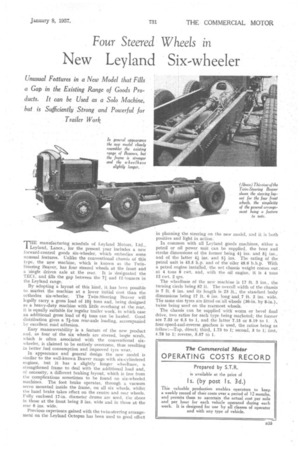Four Steered Wheels in
Page 49

If you've noticed an error in this article please click here to report it so we can fix it.
New Leyland Six-wheeler
THE manufacturing schedule of Leyland Motors, Ltd., Leyland, 'Lincs.,. for the present yearincludes a new forward-control goods six-wheeler, which embodies some unusual features. Unlike the conventional chassis of this type,, the new machine, which is known as the TwinSteering Beaver, has lour steered wheels at the front and a 'single driven axle at the rear. : It is designated the TEC1, and fills the gap between the 7i and 12-tormers in
the Leyland range. •
By adopting a layout of this. kind, it, has been possible to. market the machine at a lowerinitial cost than the orthodox six-wheeler. The Twin-Steering Beaver will legally carry a gross load of 10k tons and, being designed as.a heavy-duty machine with little overhang at the rear, it is equally suitable for 'regular trailer work: in which case au additional gross:load' of 6f tons can be hauled. Good distribution gives a 7f-ton rear-axle loading, accompanied by excellent road adhesion.
Easy manceuvrabffity is a feature of the new product and, as four of the six wheels are steered, bogie scrub, which is often associated with the conventional sixwheeler, is Claimed to be entirely overcome, thus resulting in better fuel consumption and improved tyre wear.
In appearance and general design the new model is similar to the well-known Beaver range with six-cylindered engines, but it has a slightly longer wheelbase, a strengthened frame to deal with the additional load and, of necessity, a different braking layout, which is free from the complications sometimes to be found on six-wheeled machines. The foot brake operates, through a vacuum servo mounted inside the frame, on all six wheels, whilst the hand brake takes effect on the centre and rear wheels. Fully enclosed 17-in, diameter drums are used, tile shoes in those at the front being 3 ins, wide and in those at the rear 6 ins. wide.
Previous experience gained with the twin-steering arrangement on the Leyland Octopus has been used to good effect in planning the steering on the new model, and it is both positive and light in action:
In common With all Leyland goods machines, either a petrol or oil powerunit Can be supplied, the bore and stroke dimensions of the former being 4f ins. and 5f ins., and of the latter 4f ins, and k ins. The rating of the petrol unit is 43.5 h.p.• and of the oiler 48.6 b.h.p. With a petrol engine installed,' the net chassis weight comes out. at 4 .tons 8 cwt. and, with the oil engine,it is 4 tons 12 cwt. 2 qrs.
The wheelbase of the new machine is 17 ft. 3 ins., the turning circle being 62: ft. The. overall width of the chassis is 7 ft. 6 ins, and its length is. 23 ft., the standard body dimensions being 17 ft. 6 ins, longand 7,ft. 2 ins. wide. The same size tyres are fitted on all Wheels' (36-in. by 8-in.), twins being used on the rearmost wheels.
The chassis can be. supplied-withworm or bevel final drive, two ratios for each type -being marketed; the former are 7.33 or 6.5 to 1, and the latter 7.15 or 8.19 to I. A four-speed-and-reverse .gearbox is used, the ratios being as follow:—Top, direct; third, 1.73 to I; second, 3 to first, 4.78 to 1; reverse, 5.57 to 1.




























































































